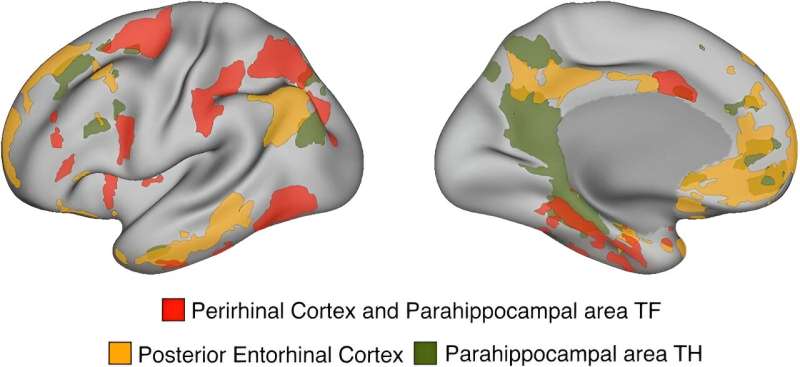This article has been reviewed according to Science X's editorial process and policies. Editors have highlighted the following attributes while ensuring the content's credibility:
fact-checked
peer-reviewed publication
trusted source
proofread
The anatomy of memory: New mnemonic networks discovered in the brain

Using a novel approach of precision neuroimaging and high-resolution functional magnetic resonance imaging (fMRI), neuroscientists and physicists at Max Planck Institute for Human Cognitive and Brain Sciences (MPI CBS) in Leipzig (Germany) and anatomist Menno Witter from the Kavli Institute for Systems Neuroscience in Trondheim (Norway) have ventured into the depths of the human memory system. They discovered previously unknown cortical networks and shed light on the anatomical organization of the human memory system. Their findings have been published in the journal Neuron.
How can the amazing abilities of our memory be explained on the basis of brain anatomy? It is known that different brain functions are anchored in different areas and structures of the brain. For example, we know that certain areas of the cerebral cortex are responsible for perception of the outer world, imagining our future, and thinking about other people. However, little is knowing about connection of the brain regions supporting these important cognitive functions with the human memory system.
The human memory system is seated in the medial temporal lobe (MTL). Broadly, it contains the hippocampus, parahippocampal cortex, perirhinal cortex, and entorhinal cortex.
"One big challenge in studying the MTL is its great anatomical variability across people. Therefore, prior studies that were using group-averaged data, blurred fine anatomical details between different subregions of the human MTL that are located in close proximity to each other. It is like studying face structure by averaging 1,000 different faces together. We will get important organizational principles of a face—where the eyes and the nose are located, where the mouth is, but we will completely loose idiosyncratic important details," explains the study's first author, Daniel Reznik of MPI CBS.
According to Reznik another challenge in studying the MTL in humans is that this brain region is strongly affected by susceptibility artifacts, therefore the ability to get good-quality signal from this brain region is highly limited.
In the current study, the scientists solved these challenges in MTL imaging and finally explored the distributed cortical anatomy associated with different subregions of the human temporal lobe in individuals.
"So instead of collecting data from many different people, we collected a lot of data from the same individuals, which dramatically increased the anatomical precision of our study. We combined our expertise in high-field imaging, neuroanatomy, and cognitive neuroscience and examined MTL anatomy in great detail. This allowed us to identify cortical networks associated with the human medial temporal lobe that were unknown to previous human memory research," Reznik concludes.
He adds, "Similar cortical networks also exist in animals and perhaps the most exciting finding is that we have now evidence for potentially new cortical pathways in the human memory system compared with non-human primates."
Christian Doeller, Director of the Department of Psychology at MPI CBS, says, "These new findings are important since even after many years of research into human memory, no one really knew how the regions in the MTL are connected with the rest of the human brain. Connectivity of the entorhinal cortex is of particular interest for us, since this is one of the first brain regions affected by Alzheimer's disease."
"Our discovery defines the anatomical constraints within which human memory functions operate and are informative for studying the evolutionary development of temporal lobe circuitry in different species. For example, data from non-human primates show only slight connections between the entorhinal cortex and the frontal cortex in comparison—in contrast, we found that these connections are more pronounced in humans."
Reznik adds, "Since one of the networks connected to the human entorhinal cortex is also involved in social processing, we suspect that it is an evolutionarily young network that may have evolved after the extensive expansion of the cortex in humans."
More information: Daniel Reznik et al, Dissociating distinct cortical networks associated with subregions of the human medial temporal lobe using precision neuroimaging, Neuron (2023). DOI: 10.1016/j.neuron.2023.05.029



















